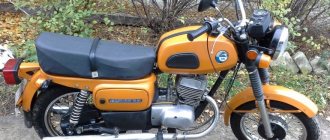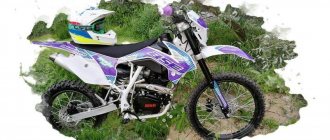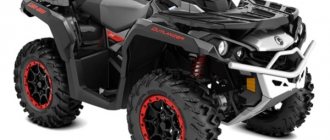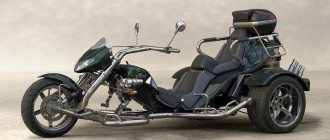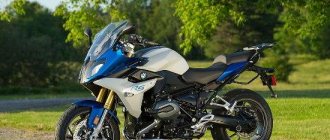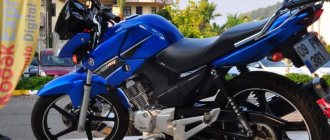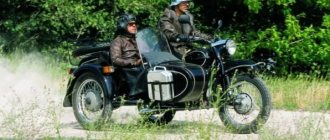Despite quite active attempts by several enterprises to establish the production and sale of scooters in the USSR, this type of equipment had difficulty taking root in our country. One of the reasons for the cool attitude of citizens towards scooters was the poor quality of roads, which did not allow all the advantages of the concept to be realized. Therefore, a new Tula motorcycle was released.
The specialists of the Tula Machine-Building Plant were aware of this problem. In 1984, a new project was implemented and the TMZ-5.951 Tula off-road motorcycle went into production. Contrary to popular belief, this model was never called Tula 200.
History of creation
The history of creation dates back to 1984, when the first 200 motorcycles rolled off the assembly line of the Tula Machine Plant named after Ryabikov and went on sale. The peak of production occurred in 1986-1988. Tula was the pioneer of Soviet SUVs with forced air cooling, as well as the first bike in the USSR to have an electric starter.
Since the plant did not have a license to produce motorcycles, it was necessary to get out of the situation by installing small scooter wheels, which transferred Tula to the category of motor vehicles. The motorcycle owes its design to a group of artists from the Leningrad branch of VNIITE, led by S. Nikolaev.
An average of 11,000 motorcycles were produced per year for 12 years. They appealed to different categories of motorcyclists, but they were especially popular among villagers who went out to hunt and fish with them. It was also quite suitable for long trips.
In the early 90s, the quality of products began to suffer, and after 1993, the production of motorcycles sharply decreased. In 1996, their production was curtailed.
Name confusion
As for the mistake with the name Tula 200, that’s a different story. This was the name of the scooter, the production of which was organized at TMZ in 1956. The model almost completely copied the German scooter Glas Goggo TA55. The car turned out to be quite successful. Tula 200 served as the basis for the following modifications, such as Tourist and Tulitsa.
Almost simultaneously with the Tourist scooter, the TGA 200, created on the same units, appeared. The basis for the design of the power units of all of the listed modifications was the T-200 engine, which appeared in 1956. Supplemented with an air cooling system and modified, the engine was also used on the Tula motorcycle. Apparently, this was the reason that some, out of habit, began to call the bike Tula 200.
Specifications
| Motorcycle brand Tula | TMZ-5.951 | TMZ-5.952 |
| Engine | two-stroke, forced cooling, 200 cc. cm | two-stroke, forced cooling, 200 cc. cm |
| Power (hp) | 12,5 | 13 |
| Petrol | A 76 | A 76 |
| Fuel capacity/reserve (l) | 11/0,5 | 11/0,5 |
| Speed (km/h) | 90 | 85 |
| Weight (kg) | 129 | 126 |
| Rated voltage (volts) | 12 | 12 |
| Wheel travel front/rear. | 130mm/80mm | 130mm/80mm |
| Transmission | four-speed | four-speed |
| Brake Diameter(mm) | 150 | 150 |
| Fuel (consumption per 100 km/l) | 3,6 | 3,6 |
Watch a video review of the Tula TMZ-5.951 motorcycle produced in 19888:
Specific approach
The concept of the car was quite interesting. A robust duplex frame, long-stroke suspension shock absorbers, an engine equipped with a forced air cooling system, tires designed for off-road driving...
All this seemed to make Tula's motorcycle very promising. However, the fate of this technology cannot be called successful. Why? Let's try to figure out the reasons. And to better understand them, let's start with the basic parameters.
Advantages and disadvantages
The advantages of Tula motorcycles, which still attract potential buyers, include:
- simplicity and ease of maintenance;
- increased cross-country ability;
- reliability in operation;
- relatively low cost;
- low fuel consumption.
Among the shortcomings are the following:
- The wiring is not located very well, as a result of which moisture, dust and dirt often penetrate into it.
- not equipped with a fairing;
- quite massive, which can be critical on a bad road;
- does not develop very high speed;
- poor stability of the bike in inclement weather and a tendency to “cut” when making turns, which is due to wide tires.
A bunch of problems
Yes, Tula’s motorcycle really moved well off-road. With the proper skill of the rider, he could even move across a plowed field. But on smooth asphalt the car felt uncomfortable. The relatively low speed and specific parameters of the engine, the main parts of which were borrowed from the unit used on the Tula 200 scooter, also had an effect.
Wide tires, which successfully cope with mud, began to slip on wet asphalt, which affected operational safety. The asymmetrical design of the motor led to a shift in the center of gravity to one side. This also did not improve handling in corners.
There wasn't enough speed. On the track, the Tula motorcycle could overtake a moped, but was seriously inferior in dynamics to traditional road motorcycles. I was also not pleased with the high fuel consumption for cars of this class. On the cars of the first series, a fuel tank was installed, consisting of two halves that did not communicate with each other. This turned out to be extremely inconvenient and was subsequently eliminated by installing a single tank.
A special concern for those who operated a Tula motorcycle was the starter-generator (dyno starter). It often broke down, providing neither reliable starting nor a normal level of battery charge. In addition, the domestic industry at that time did not produce compact twelve-volt batteries capable of generating high starting current.
At first, the car had to be equipped with two batteries, which added significant weight. The battery for the Tula motorcycle, made in a single format, appeared only on the later model. So for those who purchased the Tula motorcycle, the technical characteristics were in the background...
Modifications
Over the entire period, the Tula motorcycle has been modified three times:
- TMZ-5.951. The model was produced for 6 years, starting in 1984. It weighed 129 kg. It could reach a speed of no more than 85 kilometers per hour. The engine had a power of 12.5 horsepower.
- TMZ-5.952. Also produced for 6 years, since 1990. Equipping with a lighter frame made it possible to reduce the total weight by 3 kg. The engine has become more powerful, although only half the horsepower has increased. Speed performance increased - now it was possible to accelerate to 90 kilometers per hour.
- TM3-5.971. It began to be produced at the same time as the previous model and was actually its redesigned modification with the TMZ-9.906 cargo module. The frame has been strengthened. However, neither the engine nor the steering wheel with the front fork have undergone any changes. The model was a three-wheeled motorcycle with a trunk weighing 129 kg (without a passenger). It was also provided for attaching a trailer for 1 quintal of cargo. The connecting nodes were hidden under a plastic lining.
Tricycle Tula 5.971
Electrical equipment of the Tula T-200 scooter
The T-200 scooter is equipped with two 3-SMT-P batteries with a capacity of 11 Ah each. The batteries are connected in series, which made it possible to obtain a total voltage of 12 V. The series connection ensures that the engine starts using a dynastarter.
The DS-1 dynastarter is a direct current electric machine, which, when starting the T-200 scooter, works as an electric motor, and during driving it generates electricity to power lighting devices, ignition system devices and to recharge batteries.
When starting the engine, the dynastarter consumes a current of about 120 A, and when operating in generator mode, its power is 90 W.
Armature 1 of the dynastarter is mounted on the crankshaft and is locked using a key. Stator 3 is attached to the engine crankcase, has six poles formed by a series winding, and six poles formed by a shunt winding.
When starting the T-200 scooter, the poles of the series winding are turned on and active, and when the dynastarter operates as a generator, the poles of the shunt winding are activated.
The dynastarter works in conjunction with the relay-regulator PP-45, which provides: - turning on the dynastarter when operating as a starter; — automatic switching on and off of the dynastarter operating in generator mode from the power supply network of current consumers; - maintaining, regardless of the engine crankshaft speed, the current voltage generated by the dynastarter within certain limits.
The PP-45 relay-regulator consists of a housing in which the starting and reverse current relays and a voltage regulator are mounted.
All relay-regulator devices are closed on top with a lid.
The starting relay is switched on using the ignition key into the current circuit supplied from the battery to the stator poles formed by the series winding, and the dynastarter begins to work as a starter.
To turn off the start relay, just stop pressing the ignition key. The reverse current relay and voltage regulator are similar in their purpose, design and operation to similar devices of other types of relay regulators described above.
The B-51 ignition coil, installed on the T-200 scooter, is used to convert low voltage current (12 V) into high voltage current (14-16 thousand V).
The breaker is connected to the circuit of the primary winding of the ignition coil and ensures the induction of high voltage current in the secondary winding at the right moments.
The opening of the contacts of the breaker 10 and 11 occurs at those moments when the textolite pad 6 of the lever 9 leaves the protrusion of the cam 8, rotating on an axis fixed to the hub of the dynastarter armature.
Fixed contact 11 is located on stand 3, pressed to the base 1 of the breaker with a screw. Movable contact 10 is soldered to the end of lever 9 and connected by wire to the primary winding of the ignition coil.
For normal engine operation, the gap between the breaker contacts must be within 0.25 - 0.35 mm.
The opening of the contacts should begin at the moment when the engine piston is 3 - 4 mm before the c. m.t.
The gap between the contacts is adjusted by rotating the adjusting screw 2.
The T-200 scooter engine has an automatic ignition timing device, fixed with its base 1 to the dynastarter armature and rotates with it.
The weights 6 with their protrusions fit into the grooves of the cam 3 of the breaker. Each weight sits on a separate axis and is pulled by a spring 5 to the cam.
When the engine begins to develop speed, the weights, under the influence of centrifugal force, begin to overcome the force of the springs and move apart. In this case, the short arms of the weights turn the cam against the direction of its rotation, and the opening of the breaker contacts begins earlier.
This provides the necessary time for more complete combustion of the working mixture in the engine cylinders, which is especially necessary at high crankshaft speeds.
When the engine reaches 2500 - 3000 rpm. The weights disperse to their stops, and the machine no longer changes the achieved ignition timing.
The T-200 scooter uses A11U spark plugs with a gap between the electrodes of 0.6 - 0.7 mm.
The FG-50B headlight, installed on a T-200 scooter, consists of an optical element, a diffuser, adjustment and fastening parts. A two-filament lamp with low and high beam filaments is installed in the central socket.
The rear light serves to illuminate the license plate in the dark and to signal the braking of the scooter.
The S-30 sound signal installed on the T-200 scooter is similar in its effect to the S-34 signal on the VP-150 scooter.
Electrical diagram of the Tula T-200 scooter
The T-200 scooter has a light indicator of the selected speeds.
When any speed is turned on, the electric switch interlocked with the gear shift mechanism closes the current circuit from one of the indicator lamps.
If the gearbox is in neutral, the green warning light located on the instrument panel lights up.
The central switch with the ignition switch has three positions: - position 0 corresponds to the inclusion of electrical equipment necessary for daytime driving; — in position 1, the parking light is on; — the key installed against position 2 closes the switch slide with the contact for turning on the lighting devices when driving in the dark.
There are two warning lights mounted on the top of the switch base.
The red lamp lights up if the ignition is on and the electrical equipment is powered by the battery.
When the dynastarter begins to produce a current of 12.5 volts, the reverse current relay of the relay-regulator is activated, and the red lamp goes out.
Return to contents — ↑
Tuning options
Modern technologies make it possible to tuning a Tula motorcycle at a high level.
Tuning option No. 1
The following manipulations can be carried out:
- Install a Chinese air-cooled Racer engine (petrol, 4-stroke). The carburetor is Japanese, the working volume is 200 “cubes”.
- Install a five-speed gearbox.
- Change the battery (12-volt, capacity 7 Ah).
- Replace the brakes (drum on the front wheels, disc on the rear wheels).
The motorcycle can also be painted and, if possible, the wiring can be replaced.
The result will be a motorcycle with a power of 14.3 horsepower, capable of reaching speeds of 100-110 km/h, with a gasoline consumption of just over 2 liters per 100 km. It has a dashboard that displays the necessary parameters. The tuning version can be started using either a foot starter or an electric starter.
Transmission of the Tula T-200 scooter
The multi-plate clutch, operating in oil, is mounted on the input shaft of the gearbox and consists of four steel-reinforced plastic drive discs 3 and 5 steel driven discs 4.
The driving drum 2 has grooves into which the projections of the driving disks fit. The driven disks, with their internal protrusions, fit into the grooves of the driven drum 6. The driving and driven disks are pressed against each other by the force of five springs 13.
The drive drum, through the drive chain, receives rotation from the engine crankshaft, and when the clutch is engaged, rotation through the drive and driven disks transmits rotation to the driven drum and then to the input shaft of the gearbox.
The clutch is released by lever 17, the lower end of which, through rod 14, ball 15 and rod 16, rests on the adjusting screw 9 of the pressure plate. When the clutch is disengaged by turning the lever, the adjusting screw 9 presses the pressure plate 10, the clutch discs are released, and the engine is disconnected from the gearbox.
The gearbox installed on the T-200 scooter has four forward gears. The box is made with constant meshing of gears, with movable gears-carriages and are placed in a common crankcase with the engine.
On the input shaft 6, manufactured integrally with the first gear gear 5, the gears of the second 4 and fourth 2 gears rotate freely. The movable gear 3 is mounted on the splines of the input shaft and can move along its axis.
On the secondary shaft, gear 8 of the first gear, which is in constant engagement with gear 5, and gear 11 of the third gear rotate.
Gear 12 of the fourth gear is pressed onto the output shaft.
The movable gear 9 can move along the splines of the secondary shaft.
At the end of the secondary shaft, a sprocket 15 is mounted on splines, connected by a chain to the sprocket of the rear wheel and being the drive sprocket of the main gear.
The gears are switched by moving the movable gears 3 and 9 of the primary and secondary shafts to the appropriate positions. These movements are carried out using a switching mechanism operating from a double-armed foot lever.
The forward gear is used to transmit rotation from the engine crankshaft to the clutch drive drum gear, which is carried out using a chain placed on the crankshaft sprocket and the drum gear.
The main gear of the T-200 scooter consists of a bushing-roller chain connecting the sprocket 14 of the secondary shaft of the box with the sprocket of the drive wheel.
Return to contents — ↑
Detailed review
This representative of TMZ is fully suitable for motorcycle tourism, cross-country travel, fishing trips and solving practical problems in the village. To improve engine performance, a reed valve was installed on it. This solution achieved democratic fuel consumption, which is important for ordinary citizens. Users of the model note the high ability of the engine to adapt to changes in load while driving. And due to the massive flywheel, engine operation at any speed is rightfully considered stable.
To easily go fishing or hiking, the motorcycle frame must easily withstand all loads. In this case, the double frame (duplex) works 100% and is quite torsionally rigid. Due to this design solution, the Tula’s maneuverability and controllability are at the proper level. Don’t forget about wide-profile tires, which simultaneously provide good contact with the road and exert minimal pressure on the ground.
Note for connoisseurs
If you liked this story and are partial to the history of domestic technology, then a lot of useful information awaits you on our website. Here you can find out what is good about the Ant scooter and what advantages the Izh Jupiter-5 motorcycle has, and much more interesting things...
Previous entry Technical characteristics of the Izh Planet-3 motorcycle
Next entry Composition and parameters of electrical equipment IZ Jupiter 5
Motorcycle Features
“Tula” is an interesting motorcycle in its design and unusual in design. It consists of a small frame on which even smaller wheels are mounted. They are more suitable for scooters than motorcycles. However, this design did not affect cross-country ability in any way. The Tula motorcycle is perfect for off-road driving or, for example, on neglected rural roads.
The designers were able to achieve this effect due to a lightweight frame and a fairly powerful engine. The latter has high torque. Another feature of this motorcycle is the reduced amount of oil consumed when compared with other Russian-made bikes.

